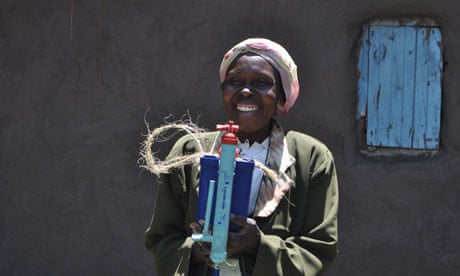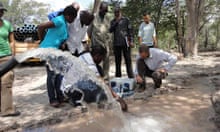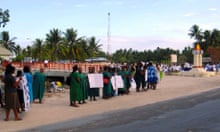Judy Sitati is going to a funeral. She is dressed in her best clothes and in her black handbag she carries a bottle of water. It is clear and safe – the product of a unique project financed by carbon credits.
"I used to buy firewood to boil water. I would spend 150 shillings [about £1] a week. Now, I use the money to buy books, or sugar for tea, or soap," says Sitati, who stops to chat to volunteers from the carbon for water project on a rutted road in Kenya's Western Province.
In April and May last year, Swiss-based disease control company Vestergaard Frandsen distributed more than 877,000 LifeStraw Family filters to households in this land of sugar cane plantations and mist-capped hills where piped water is rare and unsafe for drinking. The microbiological filter is composed of a plastic container and a long hose leading to a tube equipped with a hollow fibre filter, which catches bacteria, parasites and viruses.
The company estimates that approximately 90% of Western Province's population – about 4.5 million people – now benefit from clean water. People save money on both firewood, because they no longer have to boil water to make it safe – which in turn reduces emissions, and medicines. A recent report (pdf) estimated the cost to Kenya of deforestation at about 6bn shillings (£44m) a year.
But what makes this $30m project unique, apart from the scale, is the financing. The programme is the first safe water project to generate gold standard voluntary emissions reductions carbon credits, and has earned 1.4m credits so far.
The gold standard was established by the NGO community to enhance governance in carbon markets and drive best practice. Every six months, an independent auditor verifies the emissions reductions from the carbon for water project. Edward Hanrahan, director of ClimateCare, an independent profit-for-purpose firm that trades the credits on behalf of Vestergaard Frandsen, said the scheme was a "blueprint for a multiple outcomes project … you achieve your development objectives and environmental objectives".
The credits are purchased by large corporations, including beverage firms, healthcare companies and carmakers, to offset their emissions. The proceeds will be reinvested to make the project sustainable over 10 years. "[The financing model] pays for how much you achieve in terms of behaviour change rather than paying for implementation," says Alison Hill, managing director for climate at Vestergaard Frandsen.
This model, she says, harnesses the strengths of the private sector, where payment is tied to performance and cost efficiencies are the norm. It also offers a degree of certainty and sustainability. But there is a burden of proof. Every six months, hundreds of local LifeStraw employees, often on boda bodas (motorbike taxis), visit 15,000 to 20,000 households to evaluate use, educate, and carry out maintenance.
Francis Jerry Makwogo, a LifeStraw educator, enters mother-of-six Evelyne Naliaka's mud-walled home and uses his touch phone to scan the barcode on her filter. Using a wizard on his mobile, he questions her about the filter and her water habits; the answers form part of one of the most detailed datasets in Kenya.
Some critics of the scheme have claimed that many people in Western Province would not boil water anyway, but would instead drink water from lakes and streams without treatment. They also question whether people value products given at no cost, like the filter. Vestergaard Frandsen and ClimateCare counter, saying people may not have been boiling water before because they could not afford to, but when their economic conditions improve, they will.
However, a more serious threat to the carbon for water project may be the crash in carbon credit prices. When the project started, the average price was 10 times what it is today. "That really threatens the viability of the programme," Hill says. "It also creates an opportunity for development agencies or other funders … to relook at the way they structure donor aid and share the risk."
She says talks are under way with bilateral and multilateral funders to look at dual financing. "[Vestergaard Frandsen] does not have either the financial position or the cash to scale [the project] up … what we are looking to do is share some of the risk and financing responsibilities of the upfront capital."
Dual financing could result in other donors focusing on the health impacts of the project. "We are seeing less amoebic dysentery, less typhoid. We have not seen cholera and this was a cholera-prone region … I think LifeStraw has chased it out," says Fred Amudavi, district public health officer for Kakamega Central in Western Province.
Preliminary data suggests significant reductions in diarrhoea and dehydration in children under five. "The results are significant and … promising," says John Haskew, an academic clinical fellow in public health at Oxford University working with the Kenyan national health system. "We think we are seeing something real but clearly it is too early to know for certain," he says, adding that the next step is to do laboratory analysis to determine the type of diarrhoea, and embark on household water sampling.
The team has also built an electronic database of about 9,000 patients who are HIV positive. "We're helping to strengthen the pathways of care in the act of evaluating this … there are so many parameters that we can really start to build programmes and act on," Haskew says.
Apart from the environmental and health impacts of the carbon for water project, there is something else, explains Laban Achoka, a LifeStraw co-ordinator, as he walks from house to house along a lane lined with banana trees and corn fields. "It empowers the community," says the 28-year-old. "They have that energy and zeal because they think, 'I am healthy and tomorrow I will be healthy, and tomorrow is going to be a good day'."




Comments (…)
Sign in or create your Guardian account to join the discussion